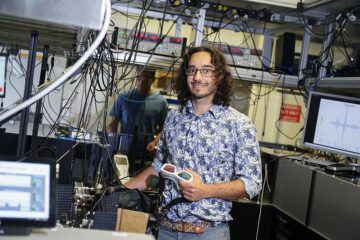T-rays: New imaging technology spotlighted by American Chemical Society

T-ray sensing and imaging technology, which can spot cracks in space shuttle foam, see biological agents through a sealed envelope and detect tumors without harmful radiation, was the focus of a recent symposium at the national meeting of the American Chemical Society.
The session was organized and chaired by experts Charles A. Schmuttenmaer, professor of chemistry at Yale, and Xi-Cheng Zhang, professor and director of the Center for Terahertz Research at Rensselaer Polytechnic Institute. Twelve speakers introduced analytic applications of terahertz spectroscopy to the analytical chemistry community.
T-rays are based on the terahertz (THz) region of the electromagnetic spectrum that is between infrared light and microwave radiation. Until recently, researchers have had great difficulty harnessing the potential of the THz region for lack of suitable radiation sources. Advanced materials research has provided new and higher power sources, and interest in THz sensing and imaging has exploded as a result.
Objects at room temperature emit thermal energy in the THz range that can be used to sense and image objects. A particular advantage of T-ray systems is that they can also give spectroscopic information about the composition of chemical and biological material, and are safer for biological applications than X-ray photons, that emit a million times more energy.
Advances presented allow sensing of extremely small objects on the nanometer scale, as well as at large distances of more than 100 meters — an essential improvement for national security applications such as remote sensing of explosives. In conjunction with NASA, THz imaging has also successfully detected defects in space shuttle foam. Other T-ray applications could enable the label-free characterization of genetic material, detect a C-4 explosive hidden in the mail, and help researchers understand the complex dynamics involved in protein folding.
Schmuttenmaer’s research uses THz technology to determine characteristics of photo-excited reactions, information that cannot be acquired with any other technique. „We have also devised a system that captures the THz pulse emitted during rapid intramolecular charge transfer using two different dye molecules,“ he said. „In the future we will use this method to probe photosynthetic and bacterial reaction centers, and perhaps DNA.“
Media Contact
Weitere Informationen:
http://www.yale.eduAlle Nachrichten aus der Kategorie: Biowissenschaften Chemie
Der innovations-report bietet im Bereich der "Life Sciences" Berichte und Artikel über Anwendungen und wissenschaftliche Erkenntnisse der modernen Biologie, der Chemie und der Humanmedizin.
Unter anderem finden Sie Wissenswertes aus den Teilbereichen: Bakteriologie, Biochemie, Bionik, Bioinformatik, Biophysik, Biotechnologie, Genetik, Geobotanik, Humanbiologie, Meeresbiologie, Mikrobiologie, Molekularbiologie, Zellbiologie, Zoologie, Bioanorganische Chemie, Mikrochemie und Umweltchemie.
Neueste Beiträge

Neue universelle lichtbasierte Technik zur Kontrolle der Talpolarisation
Ein internationales Forscherteam berichtet in Nature über eine neue Methode, mit der zum ersten Mal die Talpolarisation in zentrosymmetrischen Bulk-Materialien auf eine nicht materialspezifische Weise erreicht wird. Diese „universelle Technik“…

Tumorzellen hebeln das Immunsystem früh aus
Neu entdeckter Mechanismus könnte Krebs-Immuntherapien deutlich verbessern. Tumore verhindern aktiv, dass sich Immunantworten durch sogenannte zytotoxische T-Zellen bilden, die den Krebs bekämpfen könnten. Wie das genau geschieht, beschreiben jetzt erstmals…

Immunzellen in den Startlöchern: „Allzeit bereit“ ist harte Arbeit
Wenn Krankheitserreger in den Körper eindringen, muss das Immunsystem sofort reagieren und eine Infektion verhindern oder eindämmen. Doch wie halten sich unsere Abwehrzellen bereit, wenn kein Angreifer in Sicht ist?…





















